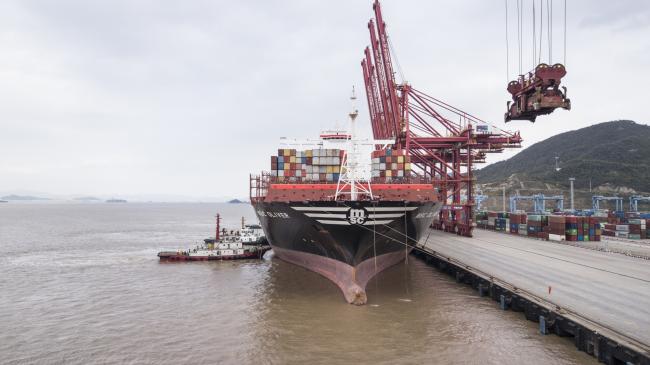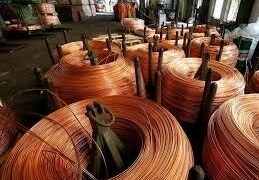 © Bloomberg. A gantry crane operates in front of the MSC Oliver container ship, operated by Mediterranean Shipping Co. (MSC) as it sits moored at the Port of Ningbo-Zhoushan in Ningbo, China, on Wednesday, Oct. 31, 2018. President Donald Trump wants to reach an agreement on trade with Chinese President Xi Jinping at the Group of 20 nations summit in Argentina later this month and has asked key U.S. officials to begin drafting potential terms, according to four people familiar with the matter. Photographer: Qilai Shen/Bloomberg
© Bloomberg. A gantry crane operates in front of the MSC Oliver container ship, operated by Mediterranean Shipping Co. (MSC) as it sits moored at the Port of Ningbo-Zhoushan in Ningbo, China, on Wednesday, Oct. 31, 2018. President Donald Trump wants to reach an agreement on trade with Chinese President Xi Jinping at the Group of 20 nations summit in Argentina later this month and has asked key U.S. officials to begin drafting potential terms, according to four people familiar with the matter. Photographer: Qilai Shen/Bloomberg(Bloomberg) — An economist who accurately predicted the rising trade tensions between the U.S. and China now sees a likely resolution of the dispute next year.
A trade deal may be reached at some point in 2019 as tariffs will start to hurt the U.S., Danske Bank A/S chief analyst and China economist Allan von Mehren wrote in a report last week, just before President Donald Trump tweeted that discussions with Chinese President Xi Jinping are “moving along nicely.”
Following the tweet, the strategist now sees a 60 percent chance of a positive outcome from a planned Trump-Xi meeting at the Group of 20 summit in Argentina from Nov. 30-Dec. 1, up from 50 percent earlier, he said in an email response to questions on Thursday. A positive outcome would mean “a clear framework for negotiation with a list of demands and a plan to go work on them one by one.”
Tensions may yet worsen before a deal can be reached, as Trump is likely to expand U.S. tariffs against Chinese imports, Mehren said. The U.S. is preparing to announce by early December tariffs on all remaining imports from China if talks at the G-20 meeting fail to ease the trade war, people familiar with the matter told Bloomberg.
“Trump’s goal is a deal. Tariffs are just a weapon,” Mehren said. “The tariffs and Chinese retaliation will also hurt the U.S. economy, so it is not sustainable.”
Copenhagen-based Mehren said in a December 2017 report that the risk of a tit-for-tat trade conflict over the coming year had increased and that the U.S. may take action in areas such as intellectual property rights, aluminum and steel, triggering retaliation by China. Since then, the U.S. has levied tariffs on $250 billion of imported Chinese goods. An escalation of the trade war has driven the yuan to its weakest level against the dollar in a decade and led to losses of nearly 20 percent in the .
Barriers to a possible trade deal remain as Beijing will continue to push ahead with its Made in China 2025 plan, the state-driven strategy to boost China’s high tech industries, according to Mehren. Still, Trump may be compelled to strike a deal if tensions start to hurt the world’s largest economy and U.S. companies are sidelined in China, he said.
For details on “Made in China 2025,” click here
A trade deal may end up resembling a Chinese offer in May, Mehren said. This may include:
- China will buy a further $70 billion to $100 billion of U.S. goods
- Take steps to strengthen intellectual property rights
- Reduce tariffs further
- No longer demand transfer of technology in joint ventures
- Further open up direct investments
- Improve conditions for foreign companies in China
- Invite U.S. companies to play a bigger role in the Made-in-China 2025 strategy through investment
Mehren’s prediction of a positive outcome from the Trump-Xi meeting this month is more optimistic than other policy watchers. BNY Mellon strategist Lale Akoner said last week the summit won’t resolve any major trade issues. George Magnus, an associate at the University of Oxford China Centre in U.K. and former chief economist at UBS, said in a series of tweets that markets shouldn’t expect too much from the meeting.
Mehren said he doesn’t rule out Trump trying to talk up markets before the mid-term elections on Tuesday and cautioned that time is needed for the U.S. and China to reach an agreement.
“A ceasefire is no guarantee of a quick deal. A real deal will take time to negotiate and there are likely to be setbacks along the way,” Mehren said. “Volatility is likely to remain but, ultimately, we do expect a deal to be made at some point in 2019.”
Fusion Media or anyone involved with Fusion Media will not accept any liability for loss or damage as a result of reliance on the information including data, quotes, charts and buy/sell signals contained within this website. Please be fully informed regarding the risks and costs associated with trading the financial markets, it is one of the riskiest investment forms possible.
Source: Investing.com




























